power steering HONDA ACCORD SEDAN 2001 Owner's Manual (in English)
[x] Cancel search | Manufacturer: HONDA, Model Year: 2001, Model line: ACCORD SEDAN, Model: HONDA ACCORD SEDAN 2001Pages: 372, PDF Size: 6.1 MB
Page 46 of 372
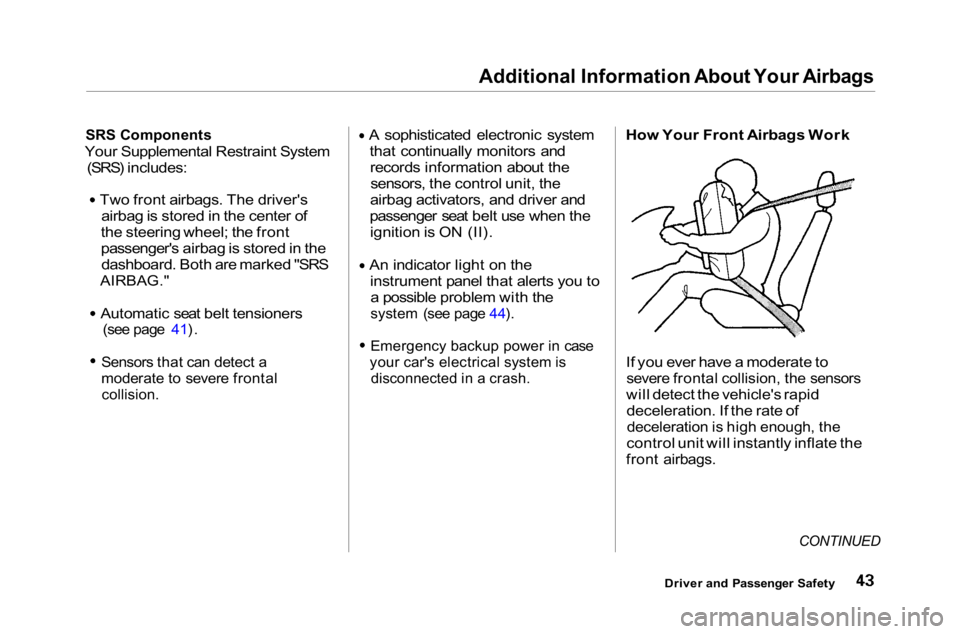
Additional Information About Your Airbags
SRS Components
Your Supplemental Restraint System (SRS) includes:
Two front airbags. The driver'sairbag is stored in the center of
the steering wheel; the front
passenger's airbag is stored in the dashboard. Both are marked "SRS
AIRBAG."
Automatic seat belt tensioners
(see page 41).
Sensors that can detect a
moderate to severe frontal
collision.
A sophisticated electronic system
that continually monitors andrecords information about thesensors, the control unit, the
airbag activators, and driver and
passenger seat belt use when the ignition is ON (II).
An indicator light on the instrument panel that alerts you toa possible problem with the
system (see page 44).
Emergency backup power in case
your car's electrical system is
disconnected in a crash.
How Your Front Airbags Work
If you ever have a moderate to
severe frontal collision, the sensors
will detect the vehicle's rapid deceleration. If the rate of
deceleration is high enough, the
control unit will instantly inflate the
front airbags.
CONTINUED
Driver and Passenger Safety
Page 54 of 372
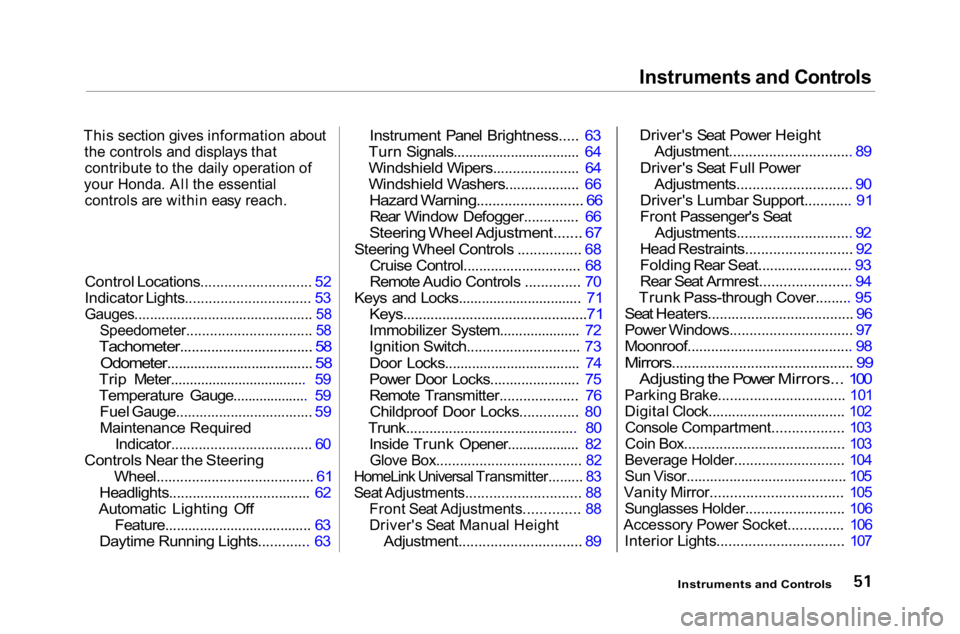
Instruments and Controls
This section gives information about
the controls and displays thatcontribute to the daily operation of
your Honda. All the essential
controls are within easy reach.
Control Locations............................ 52
Indicator Lights................................ 53
Gauges.............................................. 58
Speedometer................................ 58
Tachometer.................................. 58
Odometer...................................... 58
Trip Meter.................................... 59
Temperature Gauge.................... 59
Fuel Gauge................................... 59
Maintenance Required
Indicator.................................... 60
Controls Near the Steering Wheel........................................ 61
Headlights.................................... 62
Automatic Lighting Off Feature...................................... 63
Daytime Running Lights............. 63 Instrument Panel Brightness..... 63
Turn Signals................................. 64
Windshield Wipers...................... 64
Windshield Washers................... 66
Hazard Warning........................... 66
Rear Window Defogger.............. 66
Steering Wheel Adjustment....... 67
Steering Wheel Controls ................ 68 Cruise Control.............................. 68
Remote Audio Controls .............. 70
Keys and Locks................................ 71
Keys...............................................71
Immobilizer System..................... 72
Ignition Switch............................. 73
Door Locks................................... 74
Power Door Locks....................... 75
Remote Transmitter.................... 76Childproof Door Locks............... 80
Trunk............................................ 80 Inside Trunk Opener................... 82
Glove Box..................................... 82
HomeLink Universal Transmitter......... 83
Seat Adjustments............................. 88
Front Seat Adjustments.............. 88
Driver's Seat Manual Height
Adjustment............................... 89
Driver's Seat Power Height
Adjustment............................... 89
Driver's Seat Full Power
Adjustments............................. 90
Driver's Lumbar Support............ 91
Front Passenger's Seat
Adjustments............................. 92
Head Restraints........................... 92
Folding Rear Seat........................ 93
Rear Seat Armrest....................... 94
Trunk Pass-through Cover......... 95
Seat Heaters..................................... 96
Power Windows............................... 97
Moonroof.......................................... 98
Mirrors.............................................. 99
Adjusting the Power Mirrors... 100
Parking Brake................................ 101
Digital Clock................................... 102
Console Compartment.................. 103
Coin Box......................................... 103
Beverage Holder............................ 104
Sun Visor......................................... 105
Vanity Mirror................................. 105
Sunglasses Holder......................... 106
Accessory Power Socket.............. 106
Interior Lights................................ 107
Instruments and Controls
Page 222 of 372

Maintenance
This section explains why it is important to keep your car well
maintained and to follow basic
maintenance safety precautions.
This section also includes Maintenance Schedules for normaldriving and severe driving conditions,
a Maintenance Record, and instruc-
tions for simple maintenance tasks
you may want to take care of
yourself.
If you have the skills and tools to per-
form more complex maintenance
tasks on your Honda, you may want
to purchase the Service Manual. See page 345 for information on how toobtain a copy, or see your Honda
dealer.
Maintenance Safety....................... 220
Important Safety Precautions ..221
Maintenance Schedule.................. 222
Maintenance Record..................... 229
Owner Maintenance Checks........ 231
Fluid Locations............................... 232
Engine Oil....................................... 234
Adding Oil................................... 234Recommended Oil..................... 235
Synthetic Oil............................... 235
Additives..................................... 235
Changing the Oil and Filter...... 236
Cooling System.............................. 239
Adding Engine Coolant............. 239Replacing Engine Coolant........ 241
Windshield Washers..................... 246
Transmission Fluid........................ 247
Automatic
Transmission.......................... 247
5-speed Manual
Transmission.......................... 249
Brake and Clutch Fluid................. 251
Brake System............................. 251
Clutch System............................ 252
Power Steering............................... 252
Air Cleaner Element...................... 253
Hood Latch..................................... 256
Spark Plugs..................................... 256
Replacement............................... 256
Specifications............................. 257
Battery............................................ 260
Wiper Blades.................................. 263
Air Conditioning System............... 265
Air Conditioning Filter.................. 266 Drive Belts...................................... 266
Timing Belt..................................... 267
Tires................................................ 267
Inflation...................................... 268
Inspection................................... 270
Maintenance............................... 270
Tire Rotation.............................. 271 Replacing Tires and Wheels .... 271
Wheels and Tires....................... 272 Winter Driving........................... 273
Snow Tires.............................. 273
Tire Chains............................. 273
Lights.............................................. 274 Replacing Bulbs......................... 276
Storing Your Car............................ 285
Maintenance
Page 235 of 372
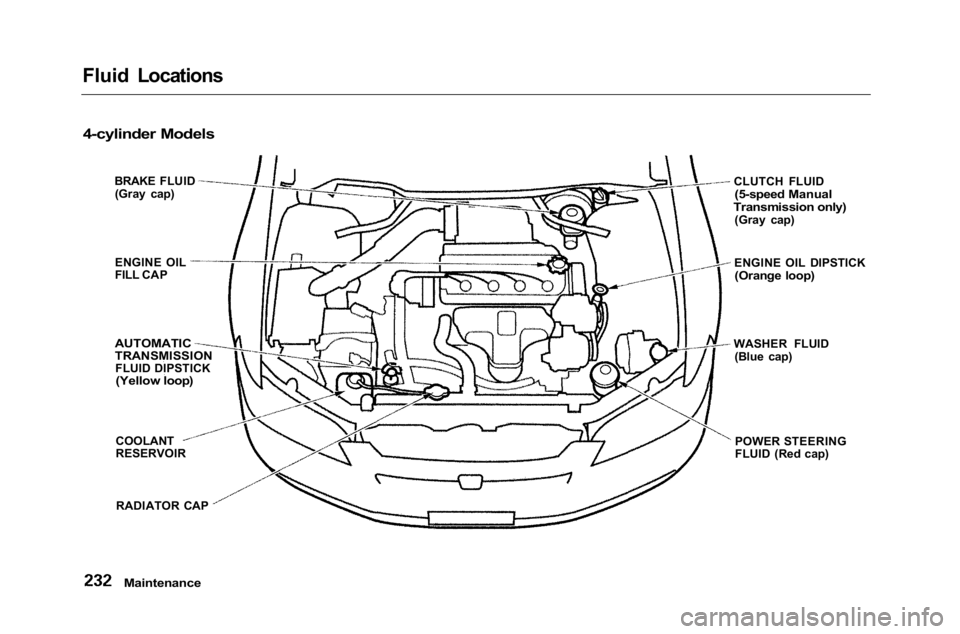
Fluid Locations
Maintenance
4-cylinder Models
BRAKE FLUID(Gray cap)
ENGINE OIL
FILL CAP
AUTOMATIC
TRANSMISSION
FLUID DIPSTICK
(Yellow loop)
COOLANT
RESERVOIR
CLUTCH FLUID
(5-speed Manual
Transmission only)
(Gray cap)
ENGINE OIL DIPSTICK
(Orange loop)
WASHER FLUID (Blue cap)
POWER STEERING
FLUID (Red cap)
RADIATOR CAP
Page 236 of 372
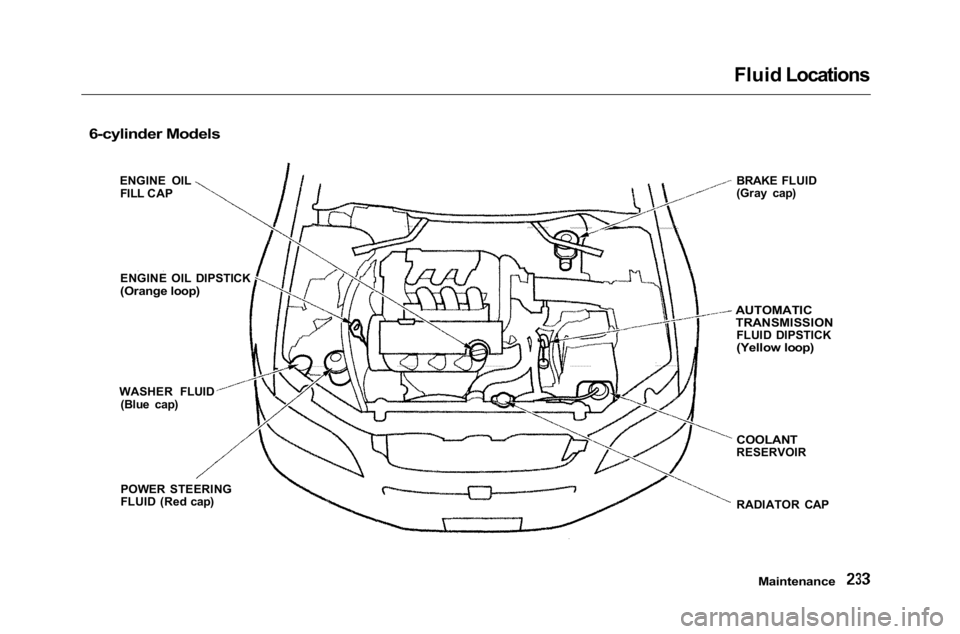
Fluid Locations
Maintenance
RADIATOR CAP
COOLANT
RESERVOIR
AUTOMATIC
TRANSMISSION
FLUID DIPSTICK
(Yellow loop)
6-cylinder Models
ENGINE OILFILL CAP
ENGINE OIL DIPSTICK
(Orange loop)
WASHER FLUID (Blue cap) BRAKE FLUID
(Gray cap)
POWER STEERING
FLUID (Red cap)
Page 255 of 372
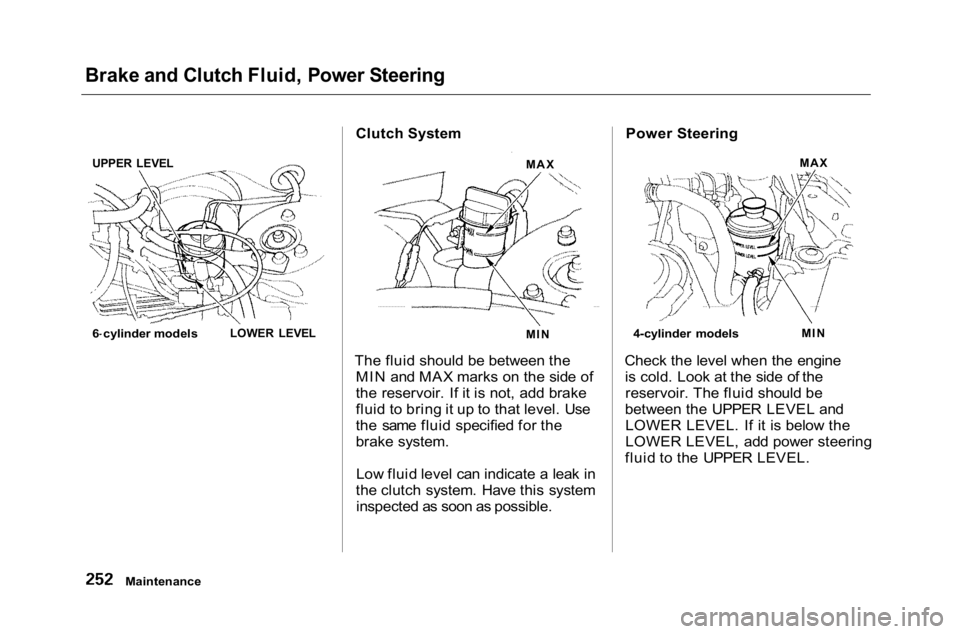
Brake and Clutch Fluid, Power Steering
Clutch System
The fluid should be between the MIN and MAX marks on the side of
the reservoir. If it is not, add brake
fluid to bring it up to that level. Use
the same fluid specified for the
brake system.
Low fluid level can indicate a leak in
the clutch system. Have this system inspected as soon as possible. Power Steering
Check the level when the engine is cold. Look at the side of thereservoir. The fluid should be
between the UPPER LEVEL and LOWER LEVEL. If it is below the
LOWER LEVEL, add power steering
fluid to the UPPER LEVEL.
Maintenance
UPPER LEVEL
6 cylinder models
LOWER LEVEL
MIN MAX
4-cylinder models
MIN
MAX
Page 256 of 372
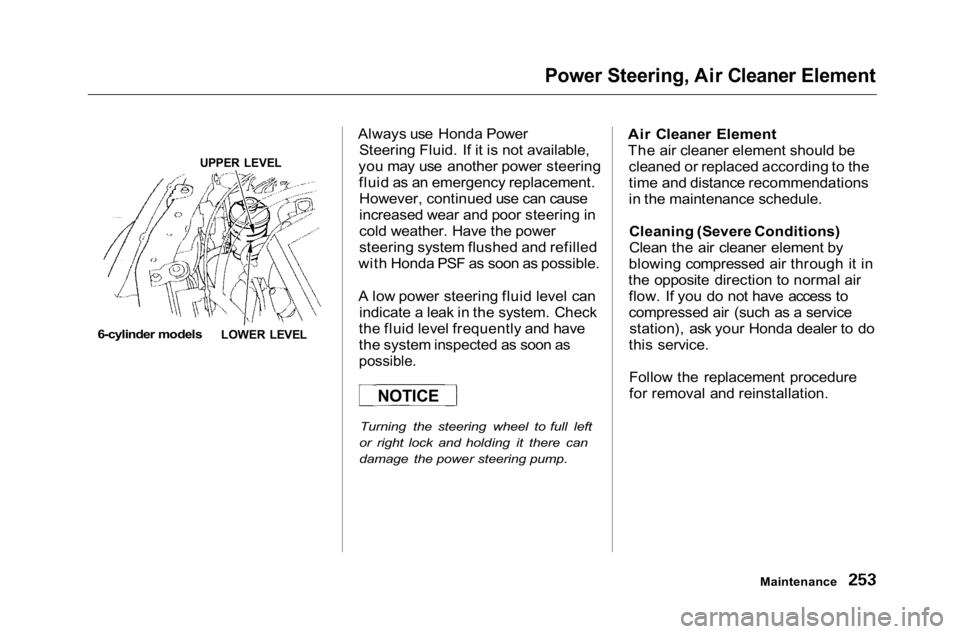
Power Steering, Air Cleaner Element
UPPER LEVEL
6-cylinder models
Always use Honda Power
Steering Fluid. If it is not available,
you may use another power steering fluid as an emergency replacement.However, continued use can cause
increased wear and poor steering in
cold weather. Have the power
steering system flushed and refilled
with Honda PSF as soon as possible.
A low power steering fluid level can indicate a leak in the system. Check
the fluid level frequently and have
the system inspected as soon as
possible.
Turning the steering wheel to full left
or right lock and holding it there can
damage the power steering pump.
Air Cleaner Element
The air cleaner element should be
cleaned or replaced according to the
time and distance recommendations
in the maintenance schedule.
Cleaning (Severe Conditions)
Clean the air cleaner element by
blowing compressed air through it in
the opposite direction to normal air flow. If you do not have access to
compressed air (such as a service station), ask your Honda dealer to do
this service.
Follow the replacement procedure
for removal and reinstallation.
Maintenance
NOTICE
LOWER LEVEL
Page 269 of 372
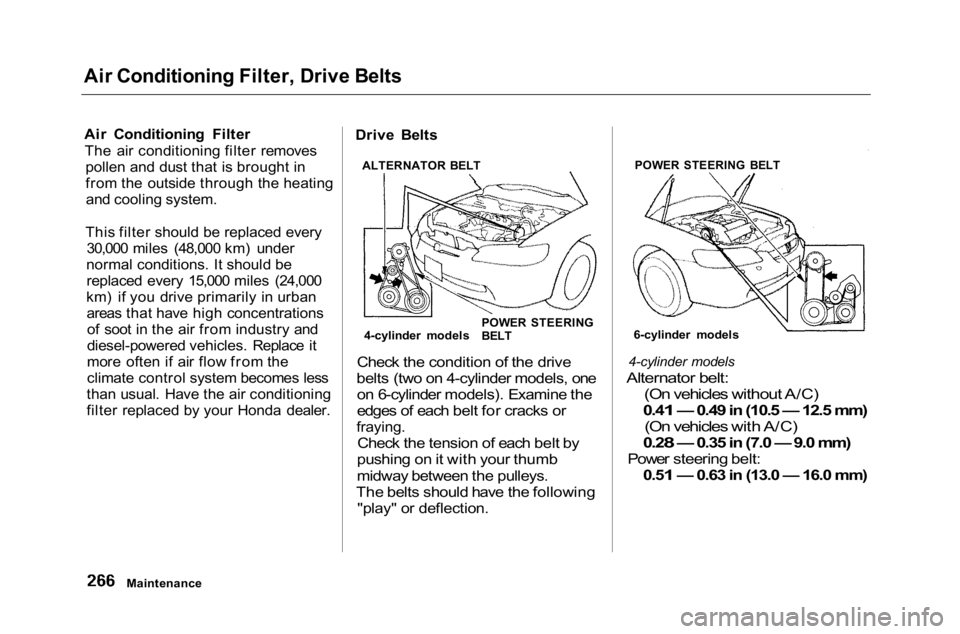
Air Conditioning Filter, Drive Belts
Air Conditioning FilterThe air conditioning filter removes pollen and dust that is brought in
from the outside through the heatingand cooling system.
This filter should be replaced every 30,000 miles (48,000 km) under
normal conditions. It should be replaced every 15,000 miles (24,000
km) if you drive primarily in urban areas that have high concentrationsof soot in the air from industry and
diesel-powered vehicles. Replace it
more often if air flow from the
climate control system becomes less
than usual. Have the air conditioning
filter replaced by your Honda dealer. Drive Belts
Check the condition of the drive
belts (two on 4-cylinder models, one
on 6-cylinder models). Examine the
edges of each belt for cracks or
fraying.
Check the tension of each belt by
pushing on it with your thumb
midway between the pulleys.
The belts should have the following
"play" or deflection.
4-cylinder models
Alternator belt: (On vehicles without A/C)
0.41 — 0.49 in (10.5 — 12.5 mm)
(On vehicles with A/C)
0.28 — 0.35 in (7.0 — 9.0 mm)
Power steering belt:
0.51 — 0.63 in (13.0 — 16.0 mm)
Maintenance
ALTERNATOR BELT
4-cylinder models
POWER STEERING
BELT
6-cylinder models
POWER STEERING BELT
Page 270 of 372
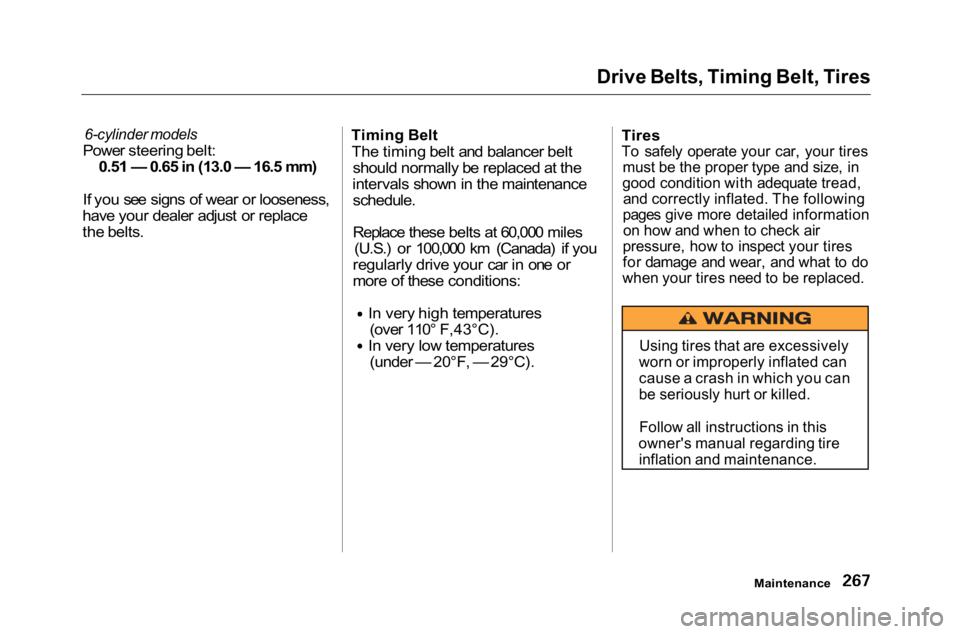
Drive Belts, Timing Belt, Tires
6-cylinder models
Power steering belt:
0.51 — 0.65 in (13.0 — 16.5 mm)
If you see signs of wear or looseness,
have your dealer adjust or replace
the belts.
Timing Belt
The timing belt and balancer belt
should normally be replaced at the
intervals shown in the maintenance
schedule.
Replace these belts at 60,000 miles
(U.S.) or 100,000 km (Canada) if you
regularly drive your car in one or
more of these conditions:
In very high temperatures
(over 110° F,43°C).
In very low temperatures
(under — 20°F, — 29°C).
Tires
To safely operate your car, your tires
must be the proper type and size, in
good condition with adequate tread,
and correctly inflated. The following
pages give more detailed information
on how and when to check air
pressure, how to inspect your tires
for damage and wear, and what to do
when your tires need to be replaced.
Maintenance
Using tires that are excessively
worn or improperly inflated can
cause a crash in which you can
be seriously hurt or killed.
Follow all instructions in this
owner's manual regarding tire
inflation and maintenance.
Page 324 of 372
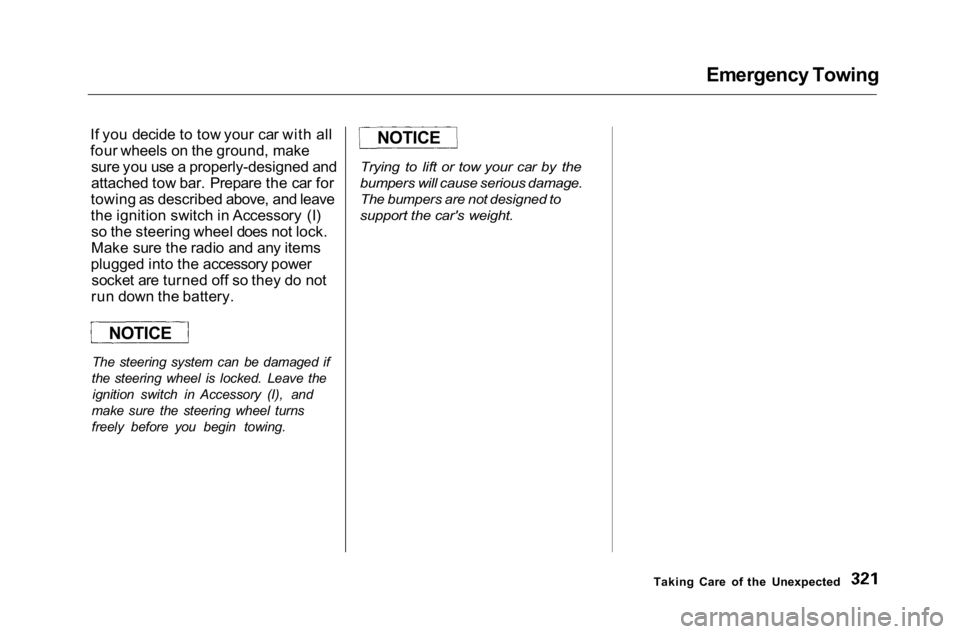
Emergency Towing
If you decide to tow your car with all
four wheels on the ground, make sure you use a properly-designed and
attached tow bar. Prepare the car for
towing as described above, and leave
the ignition switch in Accessory (I) so the steering wheel does not lock.
Make sure the radio and any items
plugged into the accessory power socket are turned off so they do not
run down the battery.
The steering system can be damaged if
the steering wheel is locked. Leave the ignition switch in Accessory (I), and
make sure the steering wheel turns
freely before you begin towing.
Trying to lift or tow your car by the
bumpers will cause serious damage.
The bumpers are not designed to
support the car's weight.
Taking Care of the Unexpected
NOTICE
NOTICE